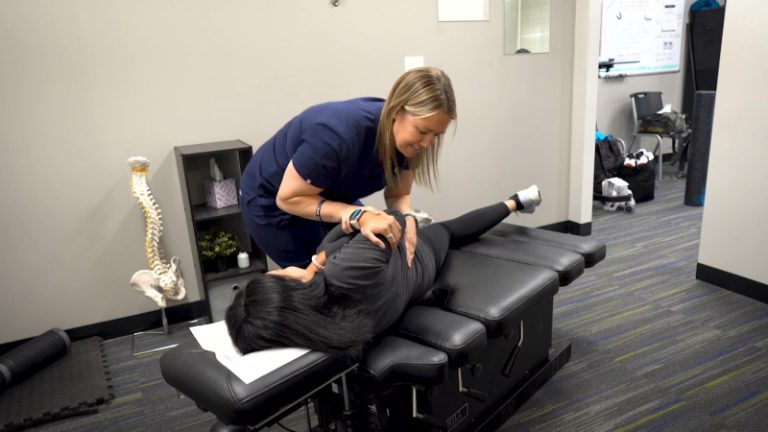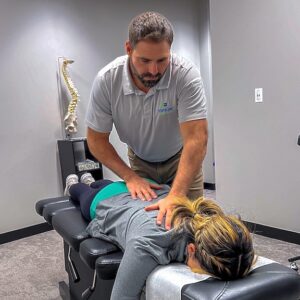Lower back pain affects millions each year – often interrupting work, sleep and daily routines. It’s among the top reasons people seek medical care. Yet the most common solutions – rest, painkillers or even surgery – may not provide lasting relief. Many are hesitant to rely on medications long term or undergo invasive procedures without exploring other options.
This is where chiropractic care comes in. Chiropractors specialize in mechanical disorders of the spine and musculoskeletal system, offering a movement-focused, drug-free alternative that addresses the root causes of pain.
Chiropractors believe that spinal misalignments and muscle imbalances can disrupt nerve function and reduce mobility – contributing to pain, stiffness and even fatigue. By using spinal adjustments, soft-tissue therapy, corrective exercises and lifestyle coaching, chiropractors support the body’s natural healing process without relying on drugs or surgical intervention.
So, for everyone wondering, “Can a Chiropractor Help With Lower Back Pain,” – the answer is yes. This article will explore how chiropractic care offers effective, personalized solutions to help reduce pain and restore mobility.
How Does Chiropractic Care Help Lower Back Pain?
Your main question is probably: “What does a chiropractor do for lower back pain?”
Well, most chiropractors try to reduce the pain and help improve patients’ functionality. They teach people how to improve their health via exercises, proper use of ergonomics or other back pain therapies.
The goal is simple: reduce pain, restore mobility and prevent recurrence. But how chiropractors achieve that goes far deeper:
Spinal Adjustments
Spinal manipulation or adjustment is the most well-known chiropractic technique. It involves applying controlled force to a joint, typically the spine, to restore mobility and realign vertebrae.
Many people find these adjustments more effective over the long term than drugs and surgery, while having the added benefit of being much safer (read our article, “Is Chiropractic Safe?” for more information on that topic).
And this isn’t just theory or some random, unproven idea. There have been many studies done showing the efficacy of these treatments. In fact, per the Harvard Medical School, spinal manipulation is considered an efficient treatment for lower back pain and helps improve range of motion (ROM) over time – often providing long-term relief.
Soft-Tissue Therapies
Lower back pain often involves tight or overworked muscles. Chiropractors use soft-tissue therapies like myofascial release, trigger point therapy or instrument-assisted methods to relieve tension, reduce inflammation and increase flexibility.
Supportive Modalities
Depending on the clinic, additional therapies such as electric muscle stimulation or therapeutic ultrasound may be used to reduce pain and encourage healing. These approaches help reduce inflammation and improve blood flow to affected areas.
Exercises and Movement Therapy
Core strengthening and mobility exercises are frequently prescribed to stabilize the spine and reduce strain on surrounding muscles. Chiropractors may guide patients through functional movements, stretches and corrective drills to support long-term spinal health.
Ergonomic Coaching
Whether you sit at a desk or work in a physical job, your body mechanics and posture matter. Chiropractors help patients adjust daily habits – such as lifting techniques or sitting posture – to prevent future flare-ups and improve spinal longevity.
Together, these therapies create a holistic care plan that can adapt with your progress – providing immediate relief and long-term functional improvement.
Chiropractic Examination Procedures For Lower Back Pain
Sometimes people feel hesitant when it comes to chiropractic care, but there is no need for that.
Chiropractors take the time to understand your unique experience of pain and your physical history. A thoughtful, thorough exam is essential before starting treatment which includes:
Initial Intake
Before starting any course of care, a quality chiropractor will examine the patient very carefully and make an initial diagnosis. They’ll look over your health history to understand various past issues that could be causing lower back pain (such as fractures, sprains, neurological disorders and other complications).
This includes a comprehensive review of your symptom timeline and screening for red flags like trauma, fever, numbness or underlying neurological issues. Chiropractors also pay attention to the duration and the severity of your symptoms. They classify them depending on how long they are lasting and how strong they are. These details help rule out more serious causes and identify mechanical triggers for your lower back pain.
Physical Exam
As mentioned, there are various reasons why lower back pain can occur. That is why your chiropractor has to perform such an in-depth examination before determining an appropriate treatment.
Chiropractors assess posture, flexibility, gait, muscle tone and joint mobility through palpation and functional tests. They’ll often test your ROM, reflexes and spinal alignment to determine where adjustments or therapies should focus.
Imaging Tools
X-rays or MRIs may be recommended if structural issues, past injuries or non-resolving symptoms are present. These tools help confirm a diagnosis and guide treatment – especially when dealing with chronic or complex pain cases.
Reassessment
Care plans aren’t static. After you have been getting regular care for a period of time, it is also a best practice for your chiropractor to perform a reexamination to determine how effective the course of care has been. Reexaminations are conducted regularly to track progress, make spinal adjustments and confirm that each therapy continues to meet your evolving needs.
Pre-Appointment Checklist:
- Wear comfortable, loose-fitting clothes
- Avoid restrictive footwear (opt for athletic shoes)
- Bring a list of current medications or previous diagnoses
- Be prepared to describe your pain symptoms in detail
How Effective is Chiropractic for Lower Back Pain?
Many people who look for chiropractic care, do it for the treatment of lower back pain. In fact, neck pain and back pain are known to be two of chiropractic care’s specialties.
According to a 2018 study from the World Health Organization, patients who chose to try chiropractic treatments reported less pain intensity, less disability and improvement in functionality. They also reported high satisfaction with their treatment and needed less pain medicine.
Additionally, a 2019 systematic review in The BMJ assessed data from 47 clinical trials and found that spinal manipulative therapy (SMT) provided modest but clinically meaningful improvements in both pain and function for people with chronic lower back pain. Notably, these outcomes were comparable to non-steroidal anti-inflammatory drugs (NSAIDs), but with a significantly lower risk of side effects.
That makes chiropractic care a great alternative for people who have already taken heavy medications but still experience persistent pain.
Self-Care & Lifestyle Strategies to Support Treatment
Your healing doesn’t stop when you leave the chiropractor’s office. These at-home strategies can help enhance your results and prevent future pain:
Ergonomic Awareness
Keep your work and home environments spine friendly. Use lumbar support when seated, raise computer monitors to eye level and avoid slouching. Adjust your sleeping position and mattress if back pain persists at night.
Micro-Breaks and Hydration
Take short breaks every 30–60 minutes to stand, stretch or walk. Staying hydrated supports disc health and muscle function.
Core Strengthening Exercises
Simple bodyweight movements like bird-dogs, planks, glute bridges and pelvic tilts can help reinforce spinal stability and reduce strain on your lower back.
Stress Reduction
Chronic stress tightens muscles and inflames the nervous system. Incorporating foam rolling, deep breathing and light movement throughout your day can help reduce tension and promote better posture.
Will Chiropractic Care Be Effective for You?
We are all unique and our bodies react differently to various forms of treatment. However, one of the things we hear from our long-term patients at Evolve Chiropractic all the time is, “Thank you so much. My back pain is finally gone. I tried everything before coming here and nothing else worked.”
Of course, your age, activity level and symptom chronicity may influence your outcome. That said, chiropractors are trained to assess these factors and customize care accordingly. It’s also important to recognize red flag symptoms that require referral to a medical provider, including loss of bowel/bladder control, severe trauma or radiating numbness.
If you’re ready to try a different approach – one grounded in movement, not medication – chiropractic care could be the key.
So many people suffer every day from lower back pain they don’t think could ever be relieved. If you are one of them, stop trying to put up with the pain, explore the modern chiropractic treatment methods and let them help you change your life for the better.
Looking for Chiropractic help? We have locations all throughout Northern Illinois:
Evolve Chiropractic Barrington, IL
Evolve Chiropractic Cumberland, IL
Evolve Chiropractic Downers Grove, IL
Evolve Chiropractic Freeport, IL
Evolve Chiropractic Gilberts, IL
Evolve Chiropractic Huntley, IL
Evolve Chiropractic Lake Zurich, IL
Evolve Chiropractic Libertyville, IL
Evolve Chiropractic McHenry, IL
Evolve Chiropractic Naperville, IL
Evolve Chiropractic Palatine, IL
Evolve Chiropractic Buehler YMCA, Palatine, IL
Evolve Chiropractic Rockford, IL
Evolve Chiropractic Schaumburg, IL
Evolve Chiropractic St. Charles, IL






